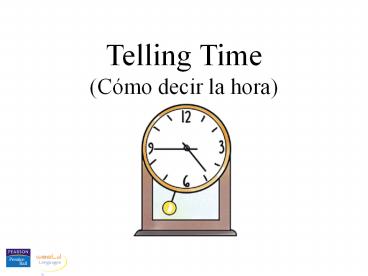Telling time - PowerPoint PPT Presentation
1 / 32
Title: Telling time
1
Telling Time
(Cómo decir la hora)
2
When we ask what time it is in Spanish, we say
Qué hora es?
Some people also say Qué horas son?
3
Qué hora es?
The third-person singular of ser is used with one
oclock since it is just one hour (hora).
Es la una.
The singular definite article is used for the
same reason.
All hours of the day are feminine in Spanish.
4
Qué hora es?
The third-person plural of ser is used with all
hours after one oclock.
Son las dos.
Likewise, the plural definite article is used for
all hours after one oclock.
5
Qué hora es?
Son las tres.
(etc.)
The formula for all hours after one is Son las
the hour.
6
Qué hora es?
Es la una y diez.
To express minutes after the hour, we simply add
y and the number of minutes.
7
Qué hora es?
Son las tres y quince.
12
1
11
or . . .
10
2
3
9
Son las tres y cuarto.
4
8
5
7
6
Cuarto is a masculine noun that means a quarter
(of an hour).
8
Qué hora es?
Son las cuatro y treinta.
or . . .
Son las cuatro y media.
Medio is an adjective that means half. It is
used in the feminine singular when telling time,
since it modifies the unexpressed noun hora.
9
Qué hora es?
Son las cinco y cuarenta.
or . . .
Son las seis menos veinte.
After the halfway point of a given hour, Spanish
gives us the option of stating the next hour
minus (menos) a number of minutes.
10
Qué hora es?
Son las siete en punto.
En punto literally means on the dot, and is
used to stress that an exact hour is being
expressed, with no minutes before or after.
11
Qué hora es?
Son las nueve menos cinco.
or . . .
Son las ocho y cincuenta y cinco.
12
Qué hora es?
Son las doce, (la) medianoche.
or . . .
Es medianoche.
Note Some Spanish speakers say Son las doce de
la noche.
13
Qué hora es?
Son las doce, (el) mediodía.
or . . .
Es mediodía.
Note Some Spanish speakers say Son las doce
del día.
14
Expressing AM time
Qué hora es?
Es medianoche.
Remember that midnight is 1200 am.
15
Expressing AM time
Qué hora es?
Es la una y veinticinco de la mañana (de la
madrugada).
Notice that in Spanish we say of the morning
rather than in the morning.
de la madrugada can be used instead of de la
mañana for the very early, or wee hours, of the
morning.
16
Qué hora es?
AM
Son las tres de la mañana.
17
Qué hora es?
AM
Son las cinco y cuarto de la mañana.
18
Qué hora es?
AM
Son las seis de la mañana.
19
Qué hora es?
AM
Son las once y media de la mañana.
20
Expressing PM time
- Qué hora es?
Es mediodía.
Remember that noon is 1200 pm.
21
Expressing PM time
- Qué hora es?
Son las dos de la tarde.
Tarde is used for afternoon and evening hours.
Notice that, again, we say of the afternoon.
22
Qué hora es?
PM
Son las cuatro y veinte de la tarde.
23
Qué hora es?
PM
Son las seis de la tarde.
tarde afternoon tarde evening
Again, tarde is used to express evening as well
as afternoon hours.
24
Qué hora es?
PM
Son las nueve de la noche.
Normally, after sundown we begin to say de la
noche however, this is somewhat variable, as it
is in English. Some feel that 700 is a good
dividing line.
25
Qué hora es?
PM
Son las once menos quince (o cuarto) de la noche.
Son las diez y cuarenta y cinco de la noche.
26
Qué hora es?
PM
Son las ocho y media de la noche.
27
Un poco de práctica
- Qué hora es?
1.
2.
AM
3.
28
Un poco de práctica
- Qué hora es?
4.
5.
PM
6.
29
A qué hora es . . . ?
When we talk about the time at which an event
begins, we must say At what time (hour) is . . .
?
To answer, we must say Es a la una, or Es a
las dos, etc.
A qué hora es la clase de español?
30
Por la mañana, etc.
A general reference to a span of time, as opposed
to a specific hour, is expressed with the
preposition por.
Tienes clases por la mañana?
Sí, todas mis clases son por la mañana, y
estudio por la tarde.
Generalmente, cuándo estudias tú, por la mañana,
por la tarde o por la noche?
31
The 24-hour clock
In many Spanish-speaking countries, the 24-hour
clock is used for schedules and official
timekeeping. The zero hour (0000) is equivalent
to midnight, and 1200 is noon. 13002400 are
the P.M. hours. To convert from the 24-hour
clock, subtract twelve hours from hours 1300 and
above.
2100 (21.00, 21,00) las nueve de la noche
1630 (16.30, 16,30) las cuatro y media de la
tarde
The punctuation used in giving the time varies
from country to country. Sometimes a period or
comma is used as well as the colon, which is
normally used in English.
32
FIN































